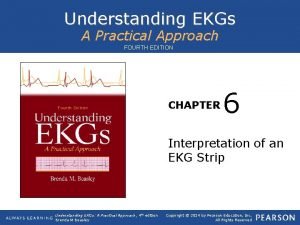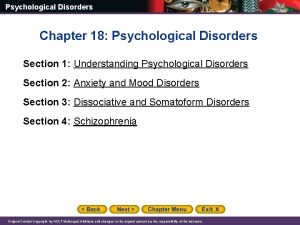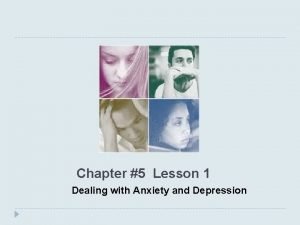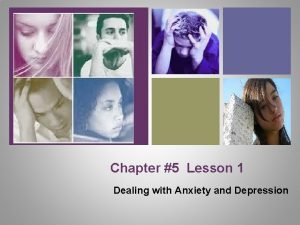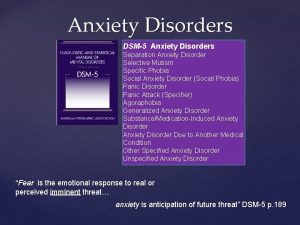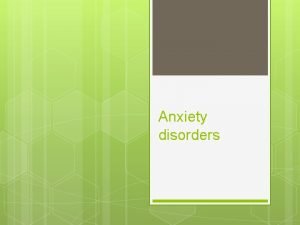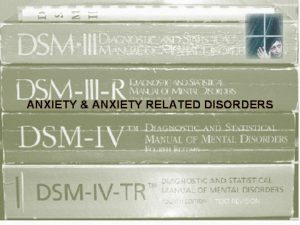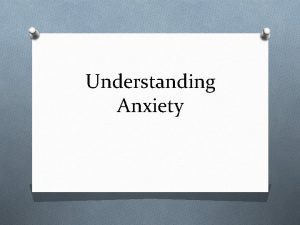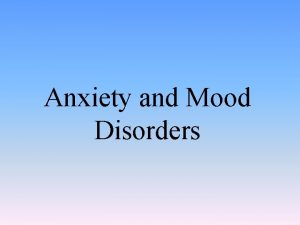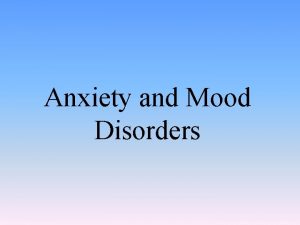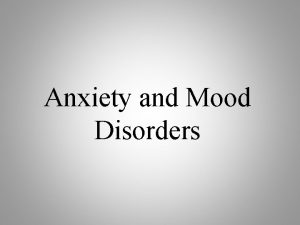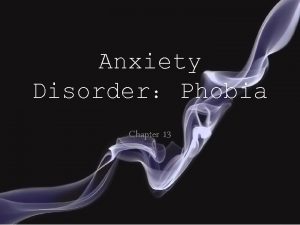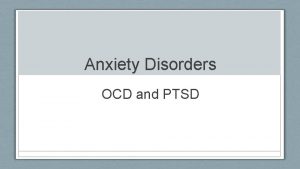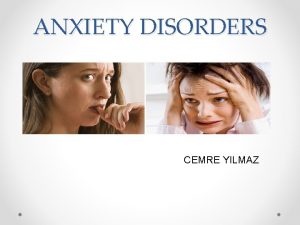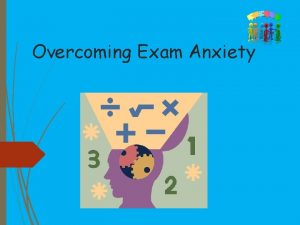Separation Anxiety Understanding separation anxiety and some practical

















- Slides: 17

Separation Anxiety Understanding separation anxiety and some practical ways to support your child. Hayley Maeder

What is anxiety and is it always bad? • Stress and anxious feelings are a common response to a situation where we feel under pressure, they usually pass once the stressful situation has passed, or ‘stressor’ is removed. Anxiety is more than just feeling stressed or worried. • Everyone feels anxious from time to time. When anxious feelings don't go away, happen without any particular reason or make it hard to cope with daily life it may be the sign of an anxiety condition. • Anxiety is the most common mental health condition in Australia. On average, one in four people – one in three women and one in five men – will experience anxiety at some stage in their life. In a 12 -month period, over two million Australians experience anxiety. • Anxiety can be broken down into other categories including separation anxiety, social anxiety, generalised anxiety and panic disorder. From beyond blue

Explaining normalised separation anxiety? It is normal for your child to feel anxious or worry when saying goodbye Usually starts around a child’s first birthday and lasts until around 4 years old Intensity level and timing vary tremendously from child to child

When is separation anxiety a concern When the issue starts to interfere with a persons normal activities such as school, play dates, sports, work etc. Normalised separation anxiety to Separation anxiety disorder

What is separation anxiety disorder? Separation anxiety disorder is NOT a normal stage of development, but a serious emotional problem characterised by extreme distress when a child is away from the primary caregiver. Main differences: Intensity of your child's fears If those fears keep them from engaging in normal activities Just the thought of leaving you may cause a heightened emotional response May complain of a sore tummy when its coming time to leave May avoid school or playing with friends School refusal It can present as mild, moderate or extreme – when symptoms are extreme and there are no other underlying diagnosis that could explain this behaviour a diagnosis of separation anxiety may be considered.

Symptoms of separation anxiety FEAR THAT SOMETHING TERRIBLE WILL HAPPEN TO A LOVED ONE. WORRY THAT AN UNPREDICTED EVENT WILL LEAD TO PERMANENT SEPARATION. REFUSAL TO GO TO SCHOOL. RELUCTANCE TO GO TO SLEEP. PHYSICAL SICKNESS LIKE A HEADACHE OR STOMACH-ACHE. CLINGING TO THE CAREGIVER.

Common causes of separation anxiety disorder

Separation anxiety occurs when a child feels unsafe in some way • Change in environment. Changes in surroundings, such as a new house, school, or day care situation, can trigger separation anxiety disorder. • Stressful situations like switching schools, divorce, or the loss of a loved one—including a pet— can trigger separation anxiety problems. • An over-protective parent. In some cases, separation anxiety disorder may be the manifestation of your own stress or anxiety. Parents and children can feed one another’s anxieties. • Insecure attachment. The attachment bond is the emotional connection formed between an infant and their primary caretaker. While a secure attachment bond ensures that your child will feel secure, understood and calm enough for optimal development, an insecure attachment bond can contribute to childhood problems such as separation anxiety.

Helping a child with separation anxiety disorder • None of us like to see our children in distress, so it can be tempting to help your child avoid the things they’re afraid of. However, that will only reinforce your child’s anxiety in the long term. Rather than trying to avoid separation whenever possible, you can better help your child combat separation anxiety disorder by taking steps to make them feel safer. Providing a sympathetic environment at home can make your child feel more comfortable. Even if your efforts don’t completely solve the problem, your empathy can only make things better.

How to support your child Educate yourself about separation anxiety disorder. If you learn about how your child experiences this disorder, you can more easily sympathize with their struggles. Listen to and respect your child’s feelings. For a child who might already feel isolated by their disorder, the experience of being listened to can have a powerful healing effect. Talk about the issue. It’s healthier for children to talk about their feelings—they don’t benefit from “not thinking about it. ” Be empathetic, but also remind your child—gently—that they survived the last separation.

Anticipate separation difficulty. Be ready for transition points that can cause anxiety for your child, such as going to school or meeting with friends to play. If your child separates from one parent more easily than the other, have that parent handle the drop off. How to support your child Keep calm during separation. If your child sees that you can stay cool, they are more likely to be calm, too. Support the child’s participation in activities. Encourage your child to participate in healthy social and physical activities. They’re great ways to ease anxiety and help your child develop friendships. Praise your child’s efforts. Use the smallest of accomplishments— going to bed without a fuss, a good report from school—as reason to give your child positive reinforcement.

Practice Practical ways to ease low level separation anxiety Practice separation. Leave your child with a caregiver for brief periods and short distances at first. As your child gets used to separation, you can gradually leave for longer and travel further. Try not to give in. Reassure your child that they will be just fine—setting consistent limits will help your child’s adjustment to separation. Develop a quick “goodbye” ritual. Rituals are reassuring and can be as simple as a special wave through the window or a goodbye kiss. Keep things quick. Leave without fanfare. Tell your child you are leaving and that you will return, then go—don’t stall or make it a bigger deal than it is. Follow through on promises. For your child to develop the confidence that they can handle separation, it’s import you return at the time you promised.

Lets get practical Short days • Look at shortening days at school when returning Safe place • Identify a safe place. Send notes • Send notes for your child to read. Draw a heart • Draw a love heart on your hand on theirs as a reminder you are always thinking about them – when they press the heart its like getting a hug from you Social stories • Read ‘My love is like a piece of string’ and give them some string to take to school. Reward

When to seek professional help • Your own patience and know-how can go a long way toward helping your child with separation anxiety disorder. But some kids with separation anxiety disorder may need professional intervention. To decide if you need to seek help for your child, look for “red flags, ” or extreme symptoms that go beyond milder warning signs. These include:

Red flags include AGE-INAPPROPRIATE CLINGINESS OR TANTRUMS WITHDRAWAL FROM FRIENDS, FAMILY, OR PEERS PREOCCUPATION WITH INTENSE FEAR OR GUILT CONSTANT COMPLAINTS OF PHYSICAL SICKNESS REFUSING TO GO TO SCHOOL FOR WEEKS EXCESSIVE FEAR OF LEAVING THE HOUSE

We are always here • The school has a wide range of people who can support you, your family and your child. We also have knowledge on external services who can assist. Please feel free to call through and ask to speak with someone on our team who could help in this transition back to school.

Contact details • HAYLEY MAEDER SOCIAL WORKER, CATHOLIC SCHOOLS OFFICE P 4979 1200 Email hayley. maeder@mn. catholic. edu. au Visit us online http: //www. mn. catholic. edu. au
 Klassenklima definition
Klassenklima definition Understanding ekgs a practical approach
Understanding ekgs a practical approach Practical understanding
Practical understanding Contact vs noncontact forces
Contact vs noncontact forces Some trust in chariots and some in horses song
Some trust in chariots and some in horses song Sam wineburg
Sam wineburg They say it only takes a little faith
They say it only takes a little faith Sometimes you win some sometimes you lose some
Sometimes you win some sometimes you lose some Is ice cream countable or uncountable
Is ice cream countable or uncountable Some say the world will end in fire some say in ice
Some say the world will end in fire some say in ice Some say the world will end in fire some say in ice
Some say the world will end in fire some say in ice Chapter 8 managing stress and anxiety
Chapter 8 managing stress and anxiety Frustration anxiety and tension
Frustration anxiety and tension Chapter 15 anxiety and obsessive-compulsive disorders
Chapter 15 anxiety and obsessive-compulsive disorders Chapter 5 lesson 1 dealing with anxiety and depression
Chapter 5 lesson 1 dealing with anxiety and depression Chapter 5 lesson 1 dealing with anxiety and depression
Chapter 5 lesson 1 dealing with anxiety and depression Cpi model
Cpi model Difference between anxiety and stress
Difference between anxiety and stress

